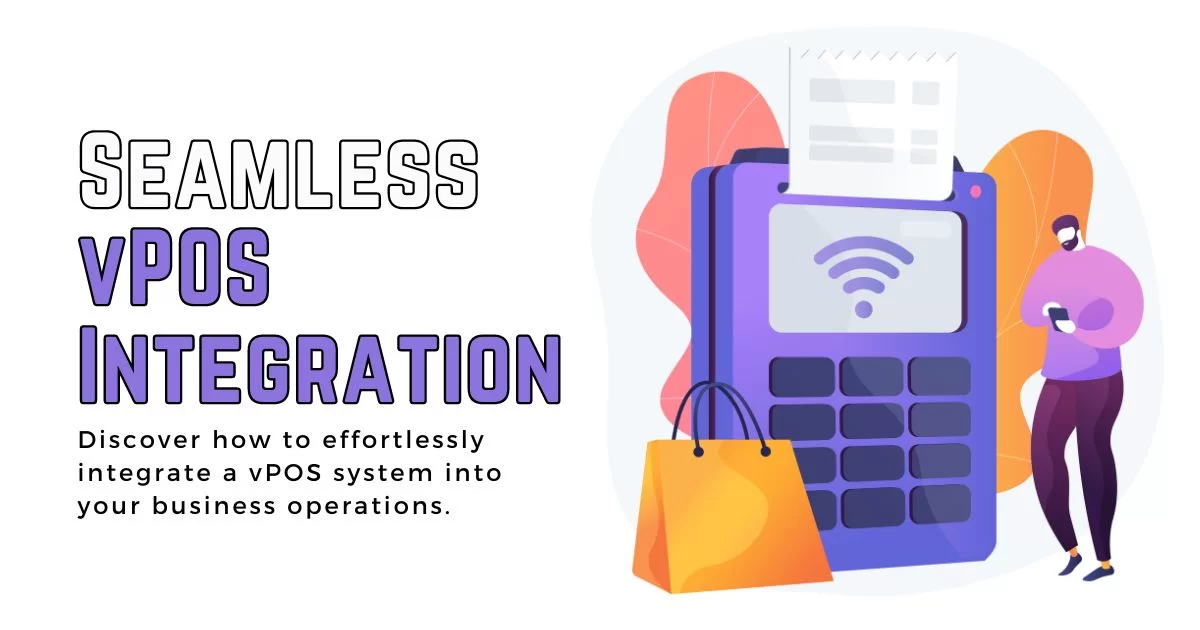
| August 28th, 2024 |
Seamless Integration of vPOS System – Boosting Efficiency & Savings!
In today’s fast-paced business environment, efficient and flexible payment processing is crucial for maintaining a competitive edge. Virtual Point of Sale (vPOS) systems have emerged as a powerful solution, offering businesses the ability to streamline their payment processes, enhance customer experiences, and reduce operational costs. In this blog, we will explore how to seamlessly integrate a vPOS system into your existing operations and the significant benefits that come with it.
What is a vPOS System?
A Virtual Point of Sale (vPOS) system is a digital platform that allows businesses to accept payments without the need for physical POS terminals. Unlike traditional POS systems, vPOS operates entirely online, enabling payments via smartphones, tablets, or computers. This technology is especially beneficial for businesses that require mobility, such as delivery services, pop-up shops, and remote service providers.
Why Integrate a vPOS System?
Integrating a vPOS system into your business operations offers numerous advantages, from improved flexibility to cost savings. However, successful integration requires careful planning and execution. Here’s how you can seamlessly integrate a vPOS system into your business.
Steps to Seamlessly Integrate a vPOS System!
1. Assess Your Business Needs:
Before selecting and integrating a vPOS system, it’s essential to evaluate your business requirements. Consider the following:
- Business Model: Determine if your business model requires mobility, such as deliveries or remote services.
- Customer Base: Understand your customers’ payment preferences, such as card payments, mobile payments, or online transactions.
- Transaction Volume: Analyze the expected volume of transactions to ensure the vPOS system can handle the load without disruptions.
Understanding these factors will help you choose a vPOS solution that aligns with your business needs and customer expectations.
2. Choose the Right vPOS Provider:
Selecting the right vPOS provider is critical for seamless integration. Look for providers that offer:
- Compatibility: Ensure the vPOS system is compatible with your existing hardware and software.
- Security: The provider should offer robust security features, including encryption, tokenization, and compliance with PCI DSS (Payment Card Industry Data Security Standard).
- Support and Training: Opt for a provider that offers comprehensive support and training to help your team adapt to the new system.
- Scalability: Choose a solution that can scale with your business as it grows.
Researching and selecting the right provider will set the foundation for a smooth integration process.
3. Plan the Integration Process:
Once you’ve chosen a vPOS provider, it’s time to plan the integration process. This involves:
- Setting Clear Objectives: Define what you aim to achieve with the vPOS integration, such as faster transactions, reduced costs, or improved customer satisfaction.
- Creating a Timeline: Establish a realistic timeline for the integration process, including milestones for each phase.
- Designating a Project Team: Assign a team responsible for overseeing the integration, including IT staff, management, and front-line employees.
- Testing the System: Before full deployment, conduct thorough testing to identify and resolve any issues.
A well-planned integration process ensures minimal disruption to your business operations and a quicker transition to the new system.
4. Train Your Staff:
For a successful vPOS integration, your staff must be well-trained on the new system. This includes:
- System Navigation: Train your team on how to navigate the vPOS interface, process transactions, and troubleshoot common issues.
- Security Protocols: Educate employees on security best practices to protect sensitive customer information and prevent fraud.
- Customer Interaction: Provide guidance on how to explain the new payment process to customers, ensuring a smooth transition.
Investing in training will boost employee confidence and ensure they can efficiently use the new system from day one.
5. Monitor and Optimize:
After the vPOS system is integrated and live, continuous monitoring and optimization are crucial. Regularly assess the system’s performance and gather feedback from employees and customers. Use this data to:
- Identify Areas for Improvement: Look for any bottlenecks or issues that need addressing.
- Update and Upgrade: Keep the system updated with the latest features and security patches to maintain optimal performance.
- Adapt to Changes: As your business grows or customer preferences shift, be ready to adapt the vPOS system to meet new demands.
Ongoing optimization ensures that your vPOS system continues to deliver value and remains aligned with your business goals.
Benefits of Implementing a vPOS System –
Integrating a vPOS system into your business doesn’t just streamline payment processes; it also offers a range of benefits that can significantly impact your bottom line and customer satisfaction.
1. Cost Savings:
One of the most compelling reasons to implement a vPOS system is the potential for cost savings. Traditional POS systems often require expensive hardware, ongoing maintenance, and software updates. In contrast, vPOS systems are typically cloud-based, reducing the need for physical infrastructure and associated costs. Additionally, many vPOS providers offer flexible pricing models, allowing businesses to choose plans that fit their budget and transaction volume.
2. Enhanced Mobility:
vPOS systems are designed for mobility, making them ideal for businesses that operate in multiple locations or offer services on the go. With a vPOS system, your staff can accept payments anywhere, whether at a customer’s doorstep, a pop-up event, or a remote worksite. This flexibility can help you expand your business operations and reach more customers without the constraints of traditional POS systems.
3. Improved Customer Experience:
Today’s consumers expect convenience and speed when making payments. A vPOS system can enhance the customer experience by offering multiple payment options, faster transaction processing, and seamless integration with mobile wallets and digital payment platforms. By providing a smooth and efficient payment process, you can increase customer satisfaction and loyalty.
4. Real-Time Data and Analytics:
vPOS systems often come with advanced reporting and analytics features, giving you access to real-time data on sales, inventory, and customer behavior. This data can help you make informed business decisions, optimize inventory management, and tailor marketing strategies to better meet customer needs. The ability to access and analyze data from anywhere also adds a layer of convenience for business owners and managers.
5. Scalability:
As your business grows, so do your payment processing needs. A vPOS system can easily scale with your business, whether you’re opening new locations, adding products or services, or increasing transaction volume. This scalability ensures that your payment processing capabilities can keep pace with your business expansion without the need for significant additional investment.
6. Enhanced Security:
Security is a top priority in payment processing, and vPOS systems are designed with this in mind. Many vPOS solutions offer advanced security features such as encryption, tokenization, and fraud detection tools. Additionally, because vPOS systems are cloud-based, they often include automatic updates to ensure compliance with the latest security standards and regulations. This level of security can protect your business from potential threats and give your customers peace of mind.
Conclusion –
Integrating a vPOS system into your business operations can offer numerous benefits, from cost savings and enhanced mobility to improved customer experiences and better security. By carefully assessing your business needs, choosing the right provider, planning the integration process, and training your staff, you can seamlessly implement a vPOS system that will streamline your payment process and support your business’s growth. As technology continues to evolve, embracing vPOS can position your business for success in an increasingly digital and customer-centric world.
